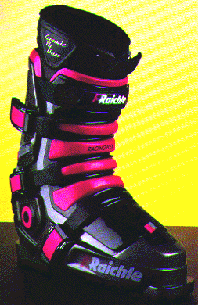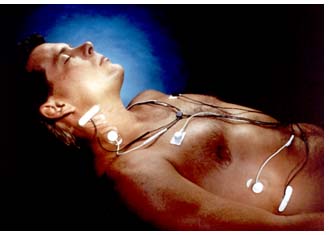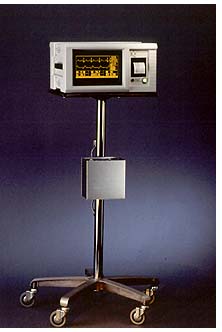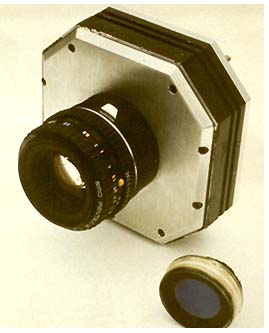
| Home |
| Introduction |
| Spinoffs |
| Perspectives |
| Examples |
| Education |
| Links |
| Credits |
| Comments |
| Statistics |
| Survey |
| 3.0 Spinoffs |
- The influence of the space program has by now become so persuasive
and is so quickly assimilated into our living patterns that we tend to
take much of it for granted. [Taylor 241]
- Household Safety
- Health and Medicine
- Communications
- Computer Technology
- Enviromental Management
The following is a very brief sampling of a few of the spinoffs that make our lives healthier, more fun, and safer.
| Food |
Nutritional Products from Space ResearchIt is difficult to imagine a connection between planetary space flight and baby food, but the connection does in fact exist. Commercially available infant formulas now contain a nutritional enrichment ingredient that traces its existence to NASA-sponsored research that explored the potential of algae as a recycling agent for long duration space travel.
The ingredient is an algae-based, vegetable-like oil known as Formulaid®. It was developed and is manufactured by Martek Biosciences Corporation, Columbia, Maryland, which has pioneered the commercial development of products based on microalgae; the company's founders and principal scientists acquired their expertise in this area while working on the NASA program. Formulaid is Martek's leading product. Its value as a dietary supplement lies in the fact that it contains two essential polyunsaturated fatty acids known as DHA (docosahexaenoic acid) and ARA (arachidonic acid). DHA and ARA, found in human milk but not in most infant formulas, are believed by many researchers to be associated with mental and visual development. ®Formulaid is a registered trademark of Martek Biosciences
Corporation.
|
| Sporting Equipment |
| SKI BOOTS
Comfort Products has once again applied NASA technology in a ski boot innovation, one that has proved highly successful with recreational skiers and has found favor among hundreds of world class competition skiers. In cooperation with Raichle Molitor USA, Inc. and the international Raichle organization headquartered in Switzerland, Comfort Products developed the Raichle Flexon concept in ski boots. The Flexon concept is an adaptation of the accordion- like corrugations of an extravehicular space suit joint, which offer astronaut flexibility of movement yet prevent kinking or distortion that might interfere with the suit's internal pressurization/temperature control equipment. Raichle uses the Flexon technology in a score of different models of its extensive line of ski and snowboarding boots. The design features a convoluted, or corrugated, configuration of the tongue (front of the boot); this design permits the complex curved stiff plastic tongue to flex without substantial distortion. The Flexon "optimized geometry," says Raichle sales literature, "provides immediate transmission of power and therefore precision skiing." Says Erik 0. Giese of Comfort Products: "The idea came from the joints in the space suit, which required articulation without distortion of a pressure vessel. It is also similar to a vacuum cleaner hose flexing without destruction, versus a paper towel tube that will bend and crimp when flexed." The technologically- advanced Raichle line also offers a "ceramic fit"
system that assures a perfect fit for every individual foot. The system
consists of a chambered "breathing" bladder, filled with tiny hollow ceramic
spheres, sewn into the inner- boot. When the user puts a foot into the
boot, the spheres adapt to the contour of the individual foot. When the
boot is buckled, the air is pressed out of the bladder and the spheres
can no longer move. This, says Raichle, provides a precise "hold" for optimal
transmission of power.
|
| Health Care |
| Cardiac Monitor
The basic method of assessing heart function is thermodilution, a procedure that involves insertion of a catheter into the pulmonary artery and is demanding in terms of cost, equipment and skilled personnel time. For monitoring astronauts in flight, NASA needed a system that was non-invasive and considerably less complex.
In 1965, Johnson Space Center contracted with the University of Minnesota to explore the then-known but little-developed concept of impedance cardiography (ICG) as a means of astronaut monitoring. A five-year program led to the development of the Minnesota Impedance Cardiograph (MIC), an electronic system for measuring impedance changes across the thorax that would be reflective of cardiac function and blood flow from the heart's left ventricle into the aorta. NASA separately contracted with Space Labs, Inc., Van Nuys, California for construction of space qualified miniaturized impedance units based on the MIC technology. The system was introduced to service aboard Space Shuttle flight STS-8 in 1983. ICG clearly had broad potential for hospital applications but further development and refinement was needed. A number of research institutions and medical equipment companies launched development of their own ICGs, using the MIC technology as a departure point. Among them were Renaissance Technologies, Inc., Newtown, Pennsylvania and Drexel University of Philadelphia, who jointly developed the IQ System®. The system provides a simple, repeatable, non-invasive way of assessing cardiac function at dramatically reduced cost; Renaissance states that the cost of the thermodilution technique runs five to 17 times that of IQ monitoring. The IQ System is in wide use in hospital Intensive Care Units, emergency rooms, operating rooms and laboratories in the U.S. and abroad.
IQ has two basic elements: the non-invasive, disposable patient interface known as IQ-Connect and the touch screen monitor, which calculates and displays cardiac output values and trends. The hardware design of the original MIC was retained but IQ has advanced automated software that features the signal processing technology known as TFD (Time Frequency Distribution). TFD provides three-dimensional distribution of the hemodynamic (blood circulation force) signals being measured, enabling "visualization of the changes in power, frequency and time." This clinically proven capability allows IQ to measure all cardiac events without using estimation techniques required in some earlier systems. ®IQ System is a registered trademark of Renaissance
Technologies, Inc.
|
| Miscellaneous |
| Night Vision Camera
Low light-level viewing devices are typically used by the military services for surveillance and intelligence-gathering activities at night or in conditions of poor visibility; they are additionally used in such applications as medical imaging and spectroscopy. Conventional low light TV imaging systems generally employ image intensifiers together with Charged-Coupled Devices (CCDs), cameras that capture scenes electronically (without film) and produce a digital image with relatively high resolution.
PixelVision, Inc., Beaverton, Oregon has introduced a new Night Video (Night Video is a trademark of PixelVision, Inc.) NV652 Back-illuminated CCD Camera that operates without an image intensifier, thereby freeing the system of certain limitations imposed by the intensifier, yet it is capable of acquiring quality images at low light levels previously attainable only with image intensifier tubes; the development drew upon technology developed by Scientific Imaging Technologies, Inc. (SITe), also of Beaverton, and on the expertise of a longtime CCD developer. Conventional video cameras use front-illuminated CCDs that impose some limitations on performance. The Night Video NV652 system illuminates and collects charge through the back surface; this design permits the image's photon to enter the CCD unobstructed, allowing for high efficiency light detection in the visible and ultraviolet wavelengths. In a typical airborne military observation application, the NV652 camera offers advantages over standard intensified CCD sensors, according to scientists who developed the back-illuminated sensor. They include greater resolution under low light conditions through increased sensitivity; better target identification through superior contrast and resolution; lower cost; and longer lifetime through increased reliability. The back illumination technology that is key to the NV652's sensitivity was developed by SITe; George M. Williams, who worked on the program as a SITe employee, has joined PixelVision as vice president and general manager of the Commercial Systems Division. The NASA technology input was provided by James R. Janesick, PixelVision vice president, chief scientific officer and director of the company's Advanced Sensors Division; Janesick was formerly with Jet Propulsion Laboratory, where he acquired 23 years of experience in CCD technology and systems design. The NV652 night vision camera is representative of a broad line of PixelVision
back illuminated low light level imaging devices for government, medical,
scientific and industrial applications. Vice president Janesick states
that the company's focus is on marketing advanced CCD technology for ultra-large,
ultra-high speed arrays used in medical, scientific and movie digital camera
systems.
|
| "Frills" |
Scratch-Resistant LensesManufactured and marketed by Bausch & Lomb, Inc., Rochester, New York, the Ray-Ban® Survivors® Collection sunglasses feature a technological advance that makes them 10 times more scratch-resistant than conventional glass lenses.
The DiamondHard® technology involves coating the lenses with a film of diamond-like carbon (DLC) that not only provides scratch-protection but additionally reduces surface friction, so that the lenses shed water more easily to reduce spotting. The film coatings are supplied by Diamonex Optical Products Group, Allentown, Pennsylvania, which employs a modified version of a dual ion beam bonding process originally developed by Lewis Research Center. The hardest substance known, diamond offers a wide range of potential applications but the potential was slow to develop because of the high cost. Interested in the possibilities of synthetic diamond coatings for aerospace systems, Lewis Research Center sought to get the advantages of diamond without the cost penalty by depositing a thin film of DLC on an inexpensive substrate (supporting material). Lewis conducted extensive research on the properties of DLC and ways to deposit the film on different types of substrates. Among the coating methods developed was a technique known as direct ion deposition, in which an ion generator creates a stream of ions from a hydrocarbon gas source; the carbon ions impinge directly on the target substrate and "grow" into a thin DLC film.
®Ray-Ban, Survivors and DiamondHard are registered trademarks of Bausch & Lomb, Inc. |
[portions taken from Spinoff 1995, Spinoff 1996]
![]()
Last Modifed
Wednesday, 10-May-2000 20:40:05 PDT
This page is brought to you by the Arizona Space Grant Consortium. Server courtesy of SEDS.

 The
formula being fed to the baby contains an algae-based additive highly enriched
in nutrients believed to be beneficial to infant mental and visual development;
called Formulaid, the additive is an offshoot of space research.
The
formula being fed to the baby contains an algae-based additive highly enriched
in nutrients believed to be beneficial to infant mental and visual development;
called Formulaid, the additive is an offshoot of space research.
 Comfort Products, Ltd., Aspen, Colorado, a design and development firm
that specializes in footwear, has been using NASA technology in its products
for two decades. The NASA association began back in the 1970s, when Comfort
Products adapted astronaut protective clothing technology to ski boot design.
Specifically, the company borrowed heating element circuitry that kept
Apollo astronauts warm or cool in the temperature extremes of the Moon,
and used it to create built-in rechargeable footwarming devices that were
supplied to leading ski boot manufacturers.
Comfort Products, Ltd., Aspen, Colorado, a design and development firm
that specializes in footwear, has been using NASA technology in its products
for two decades. The NASA association began back in the 1970s, when Comfort
Products adapted astronaut protective clothing technology to ski boot design.
Specifically, the company borrowed heating element circuitry that kept
Apollo astronauts warm or cool in the temperature extremes of the Moon,
and used it to create built-in rechargeable footwarming devices that were
supplied to leading ski boot manufacturers.
 The IQ-Connect interface electronically measures impedance changes across
the thorax to reflect heart function.
The IQ-Connect interface electronically measures impedance changes across
the thorax to reflect heart function.
 A monitor calculates and displays cardiac output values.
A monitor calculates and displays cardiac output values.
 The sensor in PixelVision's NV652 Night Video low light level camera
makes night flying safer by increasing visibility.
The sensor in PixelVision's NV652 Night Video low light level camera
makes night flying safer by increasing visibility.
 Ray-Ban Survivors Collection sunglasses feature a coating that offers
10 times the scratch-resistance of conventional glass lenses.
Ray-Ban Survivors Collection sunglasses feature a coating that offers
10 times the scratch-resistance of conventional glass lenses.
 Lewis
patented the technology and subsequently licensed it to Air Products and
Chemicals, Inc., Allentown, Pennsylvania, which was exploring aerospace
applications of diamond coatings. An Air Products spinoff company-Diamonex-used
the NASA technology along with its own proprietary technology in developing
both polycrystalline diamond and DLC coatings for commercial optical products.
Lewis
patented the technology and subsequently licensed it to Air Products and
Chemicals, Inc., Allentown, Pennsylvania, which was exploring aerospace
applications of diamond coatings. An Air Products spinoff company-Diamonex-used
the NASA technology along with its own proprietary technology in developing
both polycrystalline diamond and DLC coatings for commercial optical products.